Did you know that amongst infectious diseases, blackleg harbors a high fatality rate, often culminating in death within 12 to 48 hours post-infection in cattle? This stark fact emphasizes the urgent need for rigorous blackleg prevention and control in cattle.
Striving for optimum cattle herd health is imperative, not just for the welfare of the animals but also for the economic stability it provides to those in the agriculture sector. As a contagious and potentially devastating condition, blackleg disease in cattle demands our collective efforts to thwart its grip on livestock populations.
Understanding the gravity and rapid progression of blackleg underscores the importance of preventative measures tailored to combat this disease.
Bearing the heavy cost of loss in both life and financial investment, cattle producers must prioritize effective strategies that curtail the occurrence and spread of blackleg within herds. The subsequent sections will delve into these strategies, shedding light on the necessary steps to preserve cattle health and productivity.
Understanding Blackleg in Cattle
Blackleg disease represents a significant threat to livestock health and poses critical challenges within the cattle industry. To develop effective mitigation strategies, a deep understanding of the disease’s pathology and the hallmark blackleg symptoms in cattle is essential.
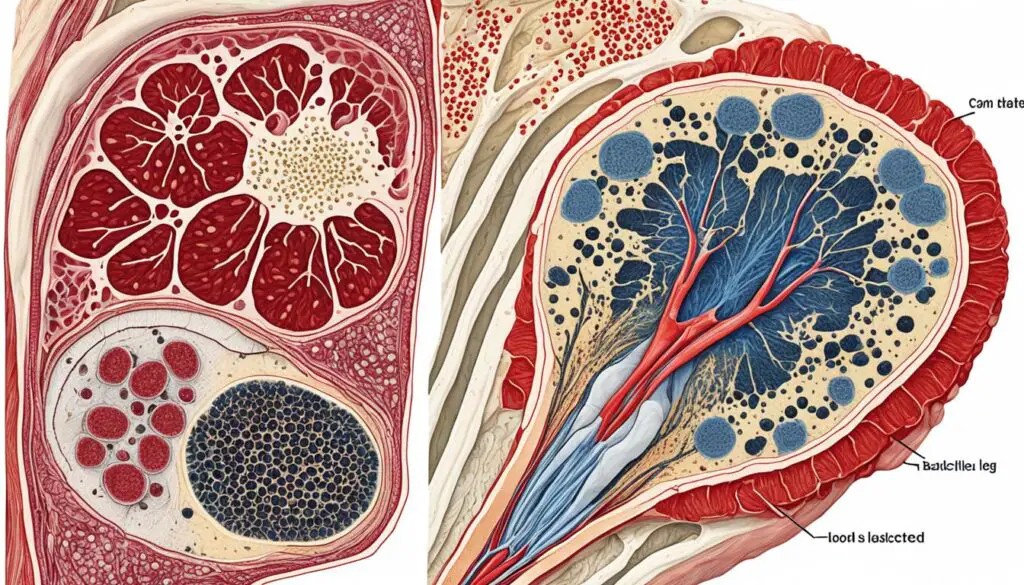
The Pathology of Blackleg Disease in Cattle
Blackleg disease pathology unfolds as a gruesome battle within the bovine body, caused by the malevolent bacterium, Clostridium chauvoei. Formidable in its resistance, this pathogen lies dormant in the soil, only to surge in unfavorable conditions.
When the muscles of cattle endure injury or suffer from an obstruction of blood, these bacteria come to life, multiplying swiftly and releasing potent toxins. The toxins infiltrate the bloodstream, causing a fatal septicemia that grapples livestock health within its deadly grip.
Recognizing Blackleg Symptoms in Cattle
Early detection of blackleg symptoms in cattle is crucial and could mean the difference between life and death. The disease manifests acutely, often with rapid deterioration. Some of the telltale signs include:
- Lameness due to muscle inflammation and damage
- Sudden swelling in the hind limbs, neck, or flanks
- Severe pain and discomfort in affected cattle
- Fever, loss of appetite, and rapid heart rate as systemic infection takes hold
- Darkened skin and muscle tissue, giving the disease its characteristic name
Upon post-mortem inspection, the carcass might display muscles that are darkened, emitting a distinct crackling sound when pressed due to gas production from the bacteria – a grim indicator of the merciless progression of this disease.
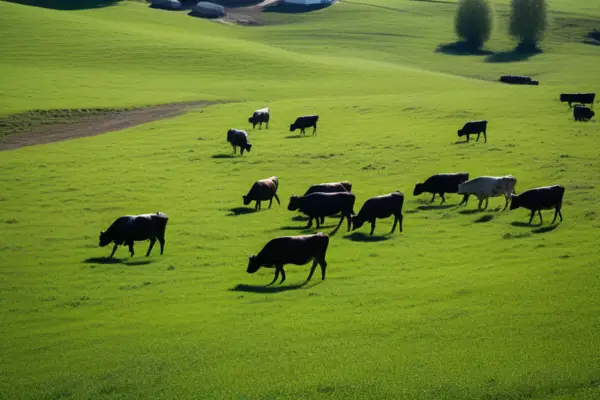
Blackleg Occurrence and At-Risk Populations
Blackleg occurrence in cattle is a serious threat to herd health, with certain groups of animals displaying a higher susceptibility to the disease. Effective management of cattle health must involve identifying these at-risk populations and understanding the environmental factors that contribute to the disease’s emergence.
Identifying Susceptible Animals to Blackleg
Identifying susceptible animals is essential for preventing blackleg outbreaks. Young cattle, particularly between 6 months and 2 years of age, are most commonly affected. These animals often exhibit superior conditioning and growth, which paradoxically may render them more vulnerable to contracting the disease. Thus, close monitoring of this demographic is paramount.
Environmental Factors Contributing to Blackleg Outbreaks
Environmental factors significantly influence blackleg occurrence in cattle, ranging from climatic conditions to the quality of pasture lands. Fluctuations in weather patterns, such as episodes of high humidity, heat, or unexpected cold snaps, can trigger outbreaks. Soil disturbances due to construction, natural disasters, or agrarian renovations have been known to free Clostridium spores from their dormant state, leading to increased infection rates during warmer months.
| Age Group | Conditioning | Risk Level | Prevalence |
|---|---|---|---|
| 6-24 months | Excellent | High | Common |
| 2+ years | Good/Varied | Moderate | Rarer |
| All Ages | Any Condition | Increased with Environmental Factors | Varies Regionally |
The impact of these conditions has been observed in regions such as New South Wales, where the incidence of blackleg can vary widely from multiple cases in one area to isolated events in another. This inconsistency underscores the importance of a tailored approach to managing blackleg, one which takes both the animal’s profile and its environment into account.
By implementing preventive strategies informed by the identification of at-risk cattle and mindfulness of environmental contributors, cattle producers can greatly reduce the risk of blackleg outbreaks, thereby protecting their livelihood and the health of their herds.
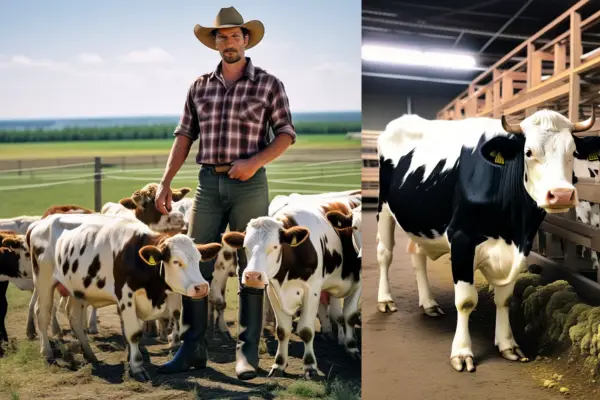
Blackleg Prevention and Control in Cattle
Addressing blackleg prevention methods is a multifaceted endeavor, critical for maintaining robust cattle health management practices. To counteract the threat of blackleg, a comprehensive approach must be employed that intertwines preventative vaccines, stringent environmental controls, and meticulous observation.
A cornerstone of blackleg control measures is the judicious use of vaccination to arm cattle against the pathogens responsible for the disease.
Implementing environmental strategies helps to minimize the interaction between cattle and latent spores that can lie dormant in the soil. Regular inspections of grazing and feeding areas are instrumental, accompanied by proper feed management protocols. Moreover, the prompt identification of any blackleg symptoms ensures immediate attention can be given, negating the likelihood of a wide-scale outbreak.
Outlined below is a table summarizing key preventive tactics that should be pursued by livestock farmers and cattle health professionals:
| Preventive Strategy | Applications | Benefits |
|---|---|---|
| Vaccination | Administering blackleg vaccine as per advised schedule | Induces immunity and reduces incidence of disease |
| Environmental Management | Monitoring soil and feed for contamination; limiting soil exposure post-disturbance | Prevents transmission of bacteria from soil to cattle |
| Early Detection | Routine health checks for early symptom identification | Facilitates timely intervention, potentially saving afflicted animals |
The effectiveness of these strategies hinges on their consistent application, ensuring each facet of prevention is holistically integrated into the cattle management routine.
Vaccination: The Cornerstone of Blackleg Prevention
Protecting livestock from the threat of blackleg disease hinges on effective vaccination protocols. Vaccination triggers a defense response within the animal’s immune system, preparing it for potential future infections. Through a series of strategically timed injections, blackleg vaccination in livestock has become the primary method to ensure long-term herd health and continuity.
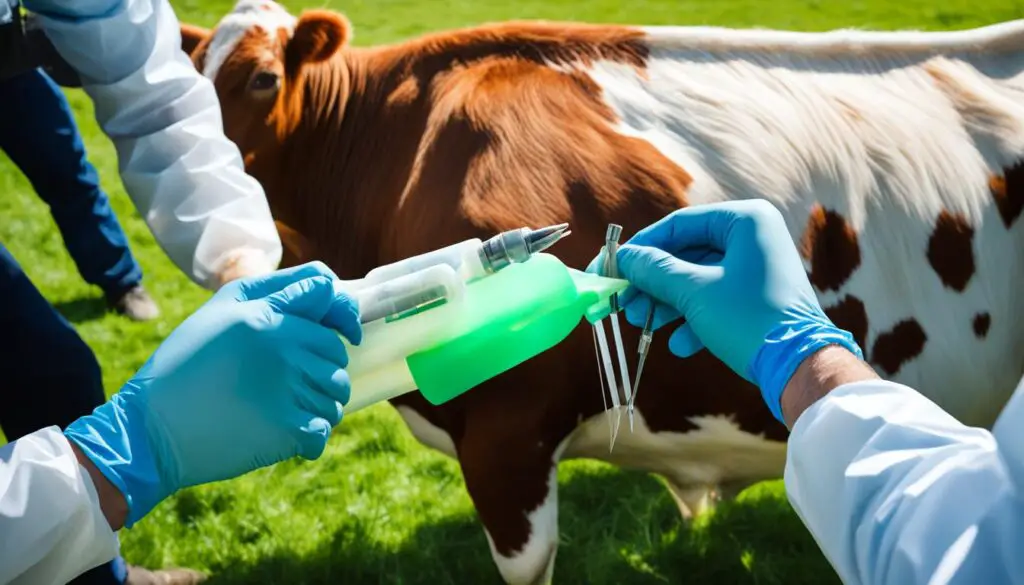
When to Administer Blackleg Vaccination in Livestock
Timing is essential when it comes to the administration of blackleg vaccines. The first dose should be given to calves at an age as young as two months, with a subsequent dose following a month later.
This ensures that the calf develops immunity before reaching the age most susceptible to blackleg infection. An annual booster is also advised to maintain robust immunity throughout the animal’s life.
The Importance of Adhering to Vaccination Schedules
Veterinary experts have meticulously designed vaccination schedules to maximize the efficacy of blackleg vaccines. These schedules are built upon understanding the epidemiology of the disease and the immunological response of cattle. Deviating from these schedules can compromise herd immunity, putting entire populations at risk.
It is through disciplined adherence to these vaccination timelines that livestock producers can safeguard their herds against blackleg’s lethal consequences.
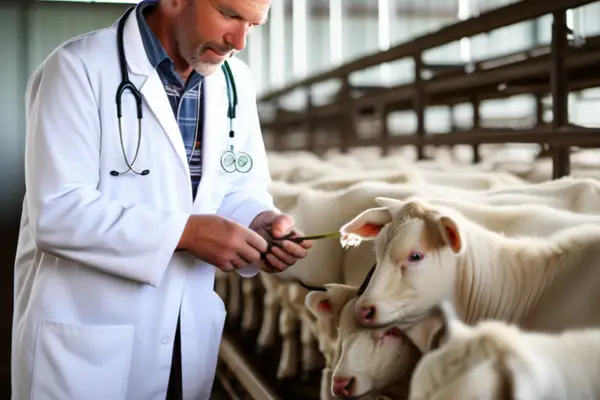
Blackleg Control Measures Beyond Vaccination
While vaccination is paramount in the defense against blackleg, a comprehensive approach to protection also involves vigilant soil management and ongoing observation for early signs of the disease. Producers can adopt various blackleg prevention strategies to safeguard their herds, ensuring the health and sustainability of livestock populations.
Managing Soil and Feed to Mitigate Blackleg Risks
Effective soil management in livestock operations is a crucial component of blackleg risk mitigation. Employing strategies that limit soil exposure and contamination can play a significant role in guarding against the ingestion of clostridial spores. Practices such as rotational grazing, avoiding overstocking pastures, and ensuring water sources are clean and free from runoff can substantially reduce the risk of blackleg transmission.
- Implement rotational grazing to decrease the risk of soil compaction and spore activation.
- Maintain proper stocking rates to minimize soil disturbance and exposure to dormant spores.
- Manage water sources carefully to prevent spore contamination from soil runoff.
Furthermore, managing feed quality to avoid contamination with soil or other potential sources of spores is another critical element of a protective strategy against blackleg.
- Store feed in a manner that minimizes contact with the ground or potentially contaminated areas.
- Inspect feedstuffs for signs of spoilage or contamination that could harbor harmful bacteria.
- Use feed additives and supplements designed to enhance the immune response of livestock.
Importance of Monitoring for Early Signs of Blackleg
Early signs monitoring is a vital aspect of a robust blackleg prevention strategy. Quick detection of symptoms such as unexplained lameness or excessive swelling can allow for timely medical intervention, potentially saving the animal and preventing the spread of infection within the herd.

Important indicators of blackleg in cattle include:
- Rapid onset of high fever
- Swollen and painful muscles, often in the leg or hip
- Depression and loss of appetite
- Dark-colored areas on the skin or under the hide
Consistency in monitoring and swiftly reacting to these early signs can prevent a manageable issue from escalating into a full-blown herd health crisis. Training farm staff to recognize such symptoms and maintaining detailed health records are all part of a comprehensive early detection program.
By combining these practices with effective vaccination protocols, cattle producers can create a multipronged defense against blackleg, one that promotes the overall well-being and productivity of their livestock. In fostering aspects of environmental stewardship alongside proactive healthcare measures, blackleg can be effectively managed and controlled.
Strategic Blackleg Vaccination Techniques and Protocols
Effective blackleg prevention in cattle herds relies on meticulous vaccination techniques and stringent handling and storage protocols. With blackleg’s potential impact on the livestock industry, these protocols are not just recommendations; they are crucial steps to safeguard cattle health and a farmer’s livelihood.
Proper Methods for Vaccine Administration in Cattle
The cornerstone of any vaccination program is the cattle vaccine administration. Vaccines for blackleg are typically administered via subcutaneous injections. This method ensures that the vaccine is delivered just under the skin, usually in the neck area, which minimizes discomfort and facilitates quicker absorption into the animal’s system.
- Choose an appropriate needle size (16 to 18 gauge and ½ to ¾ inch in length).
- Disinfect the injection site with a clean swab.
- Insert the needle at a 45° angle to the skin.
- Inject the prescribed dose gently and ensure that the vaccine does not leak.
By adhering to these techniques, the risk of site infections and improper dosing can be notably reduced, thereby enhancing the vaccine’s effectiveness in preventing blackleg.
Handling and Storage of Blackleg Vaccines
To maintain the integrity and efficacy of blackleg vaccines, proper vaccine handling and storage cannot be overlooked. It is critical that vaccines are kept at the correct temperatures from the moment they are manufactured until they are administered.
| Vaccine Handling Step | Protocol | Rationale |
|---|---|---|
| Transport | Use insulated coolers with ice packs. | Maintains potency during transportation. |
| Storage | Refrigerate between 35°F and 45°F. | Prevents vaccine spoilage and losses in efficacy. |
| Usage | Discard any unused vaccine within 24 hours of opening. | Reduces risk of contamination and ensures potency. |
Failure to follow these steps could render the vaccine ineffective, leading to increased vulnerability to blackleg in the herd and potential economic loss for the farmer. It’s the synergy of accurate blackleg vaccination techniques and the unerring vaccine administration in cattle, along with diligent vaccine handling and storage, that forges a path toward successful disease prevention and enhanced cattle welfare.
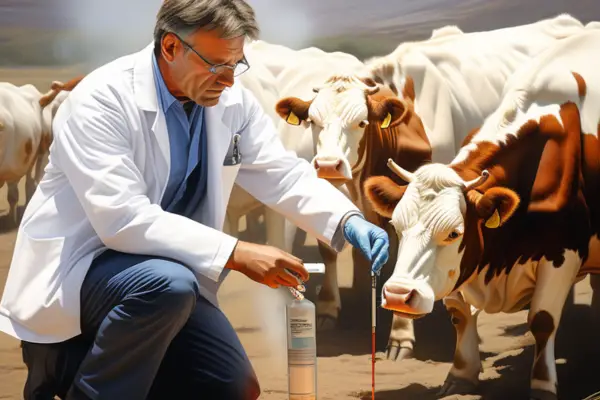
Addressing Blackleg Treatment Options and Outcomes
When confronted with Blackleg in cattle, farmers are often faced with challenging decisions regarding cattle medical intervention. The rapid progression of this disease and its often fatal results necessitate prompt and efficient treatment strategies.
Although prevention is the most effective form of defense, in cases where the disease is detected early, specific blackleg treatment options may offer some hope for afflicted livestock.
The use of antibiotics can be a critical emergency response to combat the infection in the early stages. For antibiotics to be potentially effective, however, they must be administered almost immediately upon noticing the first signs of the disease. Despite these efforts, cattle that overcome an initial infection may still suffer from extensive and irreversible muscle damage, which could affect their productivity and longevity. When treating blackleg, the following treatment protocol is generally recommended:
- Administer antibiotics as prescribed by a licensed veterinarian.
- Provide supportive care to the animal, including pain management and hydration therapy.
- Isolate the affected animal to prevent the spread of the disease.
Unfortunately, due to the rapid and aggressive nature of Blackleg, livestock disease outcomes post-treatment are often less than favorable. Permanent muscle damage and scarring can occur even in survivors, which underscores the importance of urgent care.
If treatment proves unsuccessful, it is vital for producers to consult with veterinary experts to determine the root cause. This can range from delayed treatment to improper dosing or unforeseen resistances.
When considering blackleg treatment plans, always consult with professional veterinary services and consider the wide spectrum of clinical presentations and outcomes associated with the disease.
This expertise can significantly influence the decisions made and the techniques employed in both prevention and treatment, ultimately determining the livestock disease outcomes.

Best Practices for Managing Blackleg in Livestock
Ensuring the health and vitality of livestock is paramount to maintaining a profitable farming operation, with managing blackleg in livestock standing out as a critical point of action. An effective regimen against this disease involves a multifaceted approach, where prevention is significantly more impactful than attempting to treat an established infection.
To this end, it’s important to highlight two key strategies: the implementation of an annual blackleg vaccination and the involvement of blackleg control experts to devise tailored preventive measures.
Annual Blackleg Vaccination for Herd Health Management
At the forefront of disease control is annual blackleg vaccination, a preventative measure considered indispensable in herd health management. Livestock owners are urged to embrace a regular vaccination strategy, extending its coverage to the entirety of the herd, regardless of age.
This is not only beneficial to the young or recently acquired animals but serves as a safeguard for the whole group, especially since mature cattle can harbor vulnerability to this clostridial disease. The following guidelines outline the recommended vaccination protocol:
- Primary vaccination: Administer initial vaccination followed by a booster dose.
- Annual booster: Ensure an annual booster is given to sustain immunity.
By adhering to these guidelines, farmers can significantly reduce the incidence of blackleg on their farms, thereby protecting their investment and promoting overall herd wellness.
Consulting Experts for Customized Blackleg Control Strategies
While vaccination serves as a bedrock for disease prevention, collaboration with blackleg control experts offers an additional layer of security by developing strategies uniquely suited to the conditions of a given farm. These professionals analyze factors such as environmental risks, herd composition, and local disease prevalence to provide advice that is both situationally relevant and scientifically grounded. Customized control measures may include:
- Environmental management to curtail spore activation.
- Nutritional advice to boost the herd’s natural resistance.
- Regular health checks to catch early signs of disease.
Engaging with veterinary experts for personalized guidance ensures that not only is the herd immunized, but also that all possible preventative measures are employed, fortifying the resilience of the livestock against blackleg.
Incorporating these practices into the regular management of your livestock farm can not only save lives but also sustain the economic viability of your agribusiness. Dedication to annual blackleg vaccination and consulting with accredited blackleg control experts will put you at the forefront of herd health excellence.
Conclusion
Preventing blackleg in cattle is not merely a recommended practice; it is an essential safeguard for the well-being of livestock populations across the United States.
The key to mitigating the risks of this fast-acting and oftentimes lethal disease lies in comprehensive blackleg prevention strategies that are deliberate, consistent, and research-backed. Through such measures, producers can significantly bolster herd productivity while upholding the highest standards of livestock health.
Blackleg doesn’t have to be the bane of cattle health. With regular vaccination protocols in place, vigilance in monitoring symptoms, and keen management of environmental factors, cattle producers can stay one step ahead of this condition.
The collective effort in managing and maintaining these precautions plays a crux role in the containment of blackleg, assuring the health of cattle herds nationwide.
Consultation with veterinary professionals for advanced insights into blackleg prevention and control is a wise investment in the longevity and prosperity of a cattle operation. Leveraging their expertise can lead to tailored herd health strategies, fitting the unique challenges faced by individual farms or ranches.
Ultimately, when it comes to combating blackleg, an ounce of prevention is truly worth a pound of cure, ensuring a future for livestock that is as robust as it is resilient.


